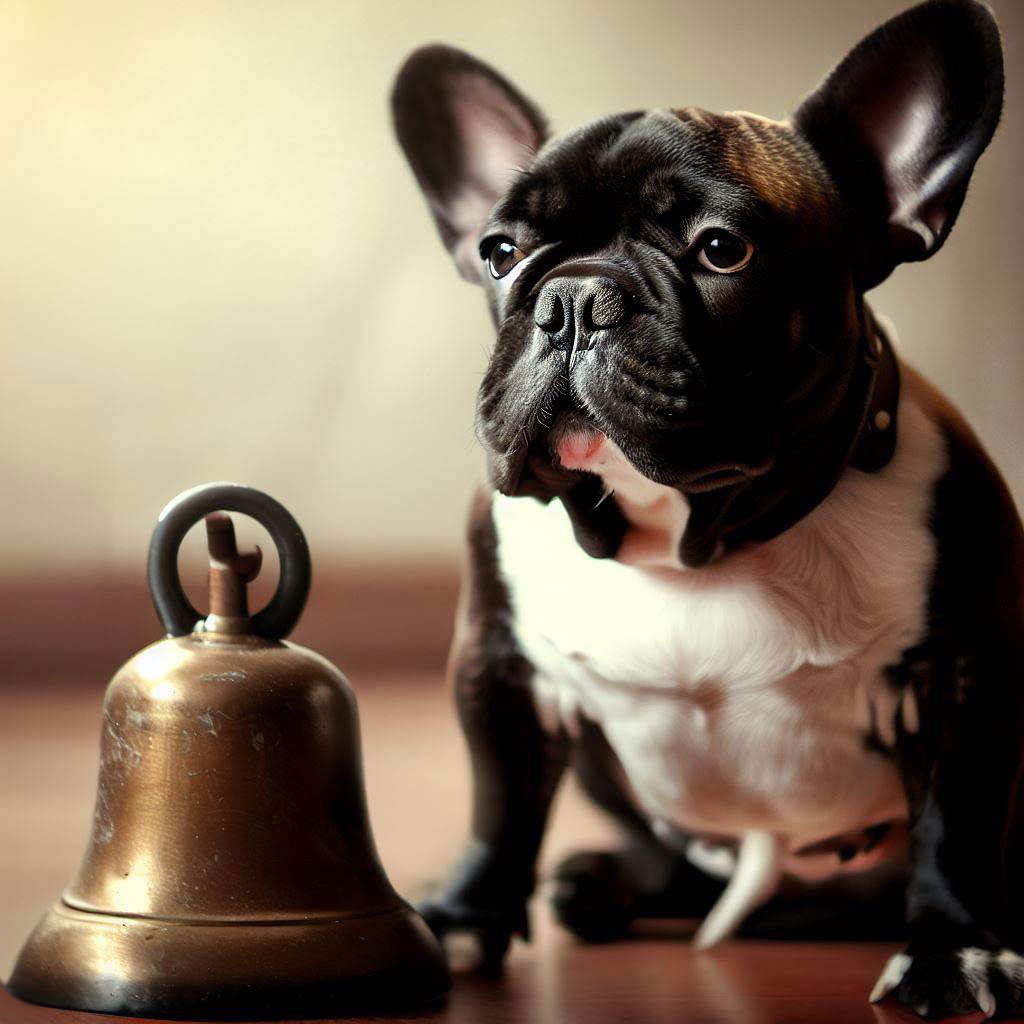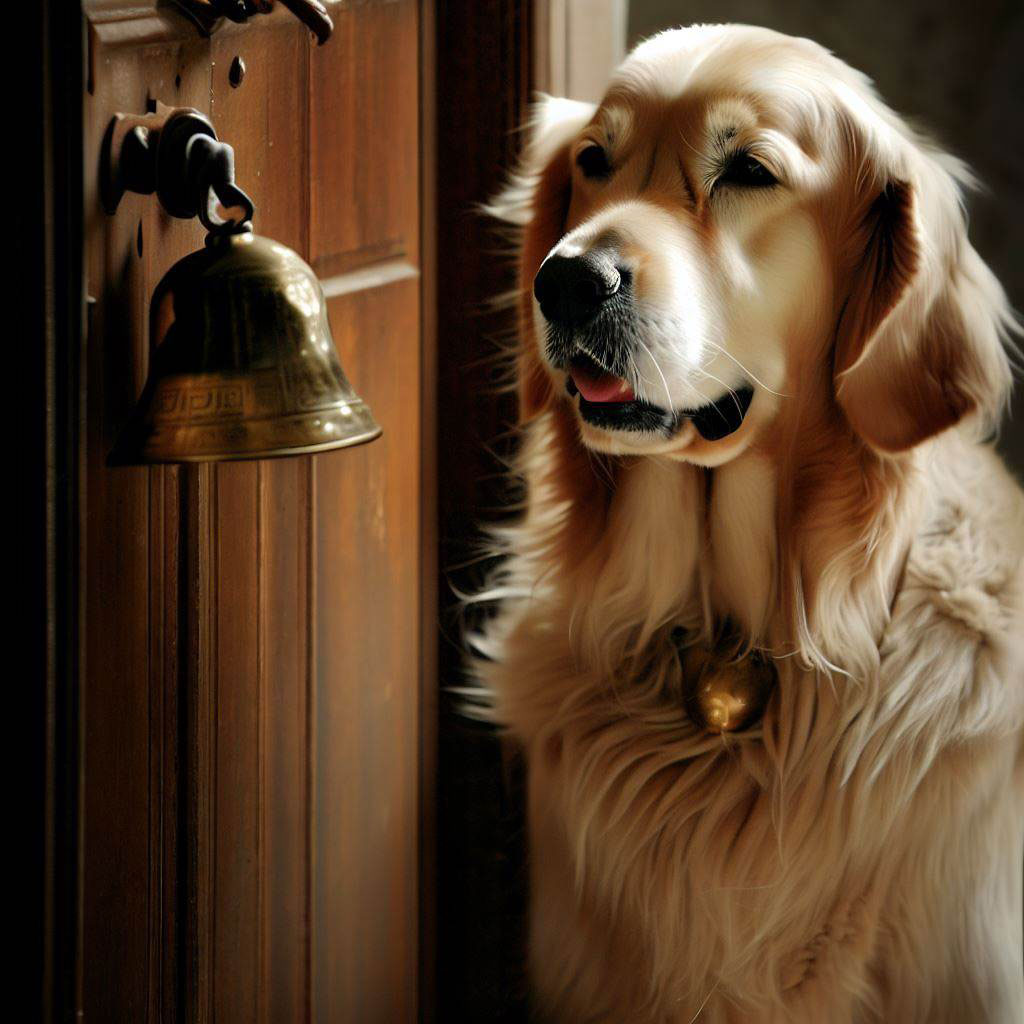How To Bell Train A Dog?
Bell Training A Dog: Train Your Puppy with Bells. Learn to create a loving and lasting bond through bell techniques.
Table of Contents
What is bell training?
At its core, bell training a dog is an innovative, non-verbal communication method. You teach your canine companion to ring a bell when they want or need something, most often signaling their desire to venture outside. This structured approach bridges the communication gap, hence making mutual understanding simpler and more direct.
Why should you consider bell training for your dog?
The answer is straightforward: clarity. While a bark, whine, or scratch at the door might leave you guessing, a bell has one clear message. When incorporated into routine, bell training a dog can revolutionize how you communicate, making interactions smoother and more predictable.
Benefits of Bell Training
Enhancing communication between owner and pet
Dogs have a plethora of ways to convey their feelings, but deciphering them can be challenging. With bell training, the guesswork diminishes. Hence, when the bell rings, you know exactly what your dog wants, strengthening the bond between pet and owner.
Promoting independence in dogs
By bell training a dog, you’re also fostering their sense of independence which empowers them, giving a clear channel to express their needs. Over time, this newfound independence often leads to a more confident, self-assured pet, unafraid to voice their desires.
Reducing accidents and unwanted behaviors
Accidents, scratches at the door, and incessant barking can be reduced, if not eliminated, through bell training. Therefore with a reliable communication tool at their disposal, dogs no longer resort to unwanted behaviors to grab your attention.
Choosing the Right Bell for Your Dog
Factors to consider: Size, sound, durability
- Size: It’s paramount that the bell is accessible to your pet. For example, smaller breeds need bells close to the ground to be ideal, whereas larger dogs might prefer something at a higher reach.
- Sound: Your dog’s comfort is key so a sound that’s audible but not jarring is optimal. After all, you wouldn’t want to startle them every time they express their need.
- Durability: Dogs can be persistent so ensure the bell can withstand enthusiastic ringing, especially if you have an energetic puppy.
Popular bell types and their advantages
- Door hanging bells: Convenient and accessible, they’re perfect for dogs accustomed to signaling at doors. Plus, an easy installation makes them a popular choice.
- Ground-based bells: Especially favored for smaller breeds, these bells are stationed at floor level and easy for a little paw to nudge.
- Wall-mounted bells: Robust and resilient, they’re often the choice for homes with larger breeds or particularly lively pets.
Preparation for Bell Training
Setting up the environment: Where to place the bell
Bell placement should align with your dog’s natural movement. Hence, it should be affixed near their regular exit door. Familiarity will encourage use, so ensure it’s in a place they frequent.
Tools needed: Treats, leash, bell
- Bell: The linchpin of this training regime. Chosen with care, it will become an essential part of your pet’s communication toolkit.
- Treats: Used for encouragement and positive reinforcement, because a little treat can go a long way in establishing new habits.
- Leash: Initially, this helps guide and focus your dog, especially when first introducing them to the bell.
Assessing your dog’s readiness
Every dog is an individual with their pace of learning so before diving into bell training, gauge their current communication habits. If they already have a routine, like waiting by the door, they might be more receptive to bell training.
Moreover, their age can be a factor as well. While it’s often said that you can’t teach an old dog new tricks, with patience, even older dogs can grasp bell training effectively. Puppies though, with their sponge-like learning ability, might pick it up faster, but also might have moments of overenthusiasm.
Ensure you’re attentive to their cues because bell training a dog is not just about teaching them; it’s a mutual learning process. You’re not only training them to use a bell but also training yourself to respond promptly and consistently. The beauty of this method is in its reciprocity, thus a two-way street of understanding and connection.
In a world where we’re constantly seeking better ways to communicate, isn’t it wonderful that something as simple as a bell can bring us closer to our beloved pets? By embracing this method, you’re not just optimizing a routine; you’re amplifying the love, trust, and understanding between you and your furry friend.

Steps to Bell Train Your Dog
1. Introduction to the Bell
Making the bell an interesting object
To kick off bell training your beloved pooch, the bell must first be an object of interest. Lay the bell on the floor and let your canine friend approach it. Most dogs, driven by their innate curiosity, will sniff or paw at it which is their way of figuring out, “What’s this new thing?”
Associating the bell with positive rewards
Once your dog shows interest, it’s time to make a positive association. So every time they touch or nose the bell, reward them with a treat or affectionate pat. This creates a mental link: bell equals good things hence this association is the first cornerstone of successful bell training a dog.
2. Teaching the Touch
Encouraging your dog to touch the bell
With the positive association in place, encourage active engagement. Use cues like “touch” or “ring” while pointing to the bell and if your dog needs a nudge, tap the bell lightly. So when they follow suit and touch it, make sure you praise them effusively.
Reinforcing the behavior with treats
Pro tip: Always keep treats on hand and every time they ring the bell, give them a treat. This positive reinforcement solidifies the behavior. And with a bit of luck, very soon your furry friend will start touching the bell even without prompting, driven by the expectation of rewards.
3. Linking the Bell to Potty Time
Ensuring consistency
Consistency is key so every time your dog rings the bell, lead them to the door, open it, and let them outside. Even if you suspect they rang it just for a treat, remain consistent. This instills the understanding: ring the bell, go outside.
Observing cues and anticipating needs
As you progress in bell training your dog, you’ll notice patterns. Maybe your dog tends to go potty after meals or during certain times of the day so anticipate these needs. Encourage them to ring the bell around these times, guiding them towards the door.
4. Reinforcing and Troubleshooting
What to do when your dog rings the bell too often
Overzealous bell ringing can happen, especially if your pet is particularly fond of treats. If they’re ringing the bell excessively without needing to go out, it’s time to adjust your approach. Initially, respond to every ring, but if they don’t potty, lead them back inside without a treat and they’ll soon catch on.
Positive reinforcement vs. negative reinforcement
Always lean towards positive reinforcement. Celebrate successes, and if they make mistakes, avoid scolding. Negative reactions can confuse them and making them hesitant to use the bell. Instead, refocus on the correct behavior, rewarding them when they get it right.
5. Gradually Phasing Out Treats
Transitioning to verbal praise and pets
After consistent bell use for potty breaks, it’s time to reduce treat dependency. Instead of a treat every time, switch to verbal praise like “good job” or “good boy/girl”. Complement them with affectionate pats or belly rubs because dogs, being social creatures, value this feedback immensely.
Ensuring the bell ringing remains consistent
While transitioning away from treats, closely monitor your dog’s bell behavior. They should still ring it consistently when they need to go out. If they seem hesitant, revert to treats for a short time and then gradually phase them out again. The ultimate goal of bell training a dog is to ensure they equate bell ringing with going outside, irrespective of treats.
Bell training your dog is a journey, one that fosters clearer communication and deepens the bond between you two. Through patience, consistency, and positive reinforcement, you’ll have a seamlessly trained canine companion in no time.
Tips and Tricks for Successful Bell Training
Addressing potential challenges and solutions
Bell training a dog is an effective way to streamline communication with your canine companion, but like any training endeavor, challenges can arise. One common challenge is a dog’s over-enthusiasm. Some dogs, realizing that ringing the bell garners attention, may do it incessantly so to combat this, ensure that every ring leads to a potty break. If they don’t do their business, guide them back inside without rewards. Over time, they’ll correlate bell rings strictly with bathroom breaks.
Another challenge might be a dog’s hesitancy or fear of the bell so remember to introduce the bell in a non-threatening manner. Place treats around it or playfully engage with the bell yourself, showing them there’s nothing to fear.
Encouraging consistency in routines
Consistency is the backbone of successful bell training. Set a routine right from the start hence if you’re home, respond immediately when the bell rings. This consistent response reinforces the bell’s purpose in the dog’s mind. Similarly, place the bell in a consistent location, preferably near the door you use for potty breaks.
The role of patience in bell training
Bell training a dog is not an overnight feat. It requires patience and there will be days of progress and many days of setbacks. Dogs, like humans, have their own learning curves. Hence some may pick up the cue within days, while others might take weeks. Celebrate small victories, like the first time they ring the bell without prompting. On days with setbacks, take a deep breath, refocus, and try again. Remember, every dog is unique; and comparing your dog’s progress to another’s isn’t productive.
Conclusion
The benefits and effectiveness of bell training
Bell training is more than just a neat trick; it’s a bridge of communication between you and your dog. This simple tool can alleviate potential frustrations caused by accidents and provides your dog with a clear way to communicate their needs. It’s a method endorsed by countless dog trainers for its effectiveness.
Reiteration of the importance of patience and consistency
We cannot stress enough the role of patience and consistency in bell training a dog. These two elements intertwine in the dance of dog training. Consistency ensures that the dog understands the desired behavior, while patience allows room for the dog to grow, understand, and internalize the behavior. Without these two pillars, the foundation of training becomes a shaky one at best.
Encouraging readers to share their own experiences and success stories with bell training
Your journey in bell training your dog will be filled with moments of joy, laughter, perhaps some frustration, but ultimately, immense satisfaction. We encourage you to share these moments with fellow dog lovers. Your experiences, be it challenges you’ve overcome or creative solutions you’ve employed, can be immensely valuable to someone else on a similar journey. Moreover, success stories always inspire. So, as you progress in this endeavor, take a moment to share, inspire, and be inspired.

FAQs: Bell Training A Dog: Train Your Puppy with Bells
What is bell training for dogs?
Bell training for dogs is a method of teaching a dog to use a bell to signal specific needs or wants, such as going outside to potty. It utilizes positive reinforcement and association techniques.
How long does it take to bell train a dog?
Bell training a dog varies in duration depending on the dog’s temperament, age, and previous training experiences. While some dogs may pick it up within a few days, others might take several weeks. Remember, patience and consistency are key.
Can older dogs be bell trained or is it only effective with puppies?
Absolutely! While puppies might grasp new concepts faster, older dogs can definitely learn bell training. In fact, senior dogs often have a better attention span, which can be advantageous during training sessions.
What should I do if my dog becomes scared of the bell?
If your dog shows fear towards the bell, introduce it slowly. Start by placing it in their play area without drawing attention to it. Over time, incorporate the bell into play sessions and reward your dog when they show curiosity towards it. Never force the bell on a fearful dog.
How can I differentiate between a dog ringing the bell for potty needs and just wanting attention?
Bell training a dog requires keen observation. If your dog rings the bell, always lead them outside. If they don’t do their business but seem playful, it’s likely they’re seeking attention. Over time, consistently guiding them out post-ring will reinforce the bell’s primary purpose.
How do you train a dog to use a bell to go out?
Start by introducing your dog to the bell. Every time you go out for a potty break, gently tap their paw or nose against the bell. Soon, with positive reinforcement (like treats), they’ll associate ringing the bell with going outside. Over time, your dog will ring the bell independently when they need a break.
What if my dog rings the bell too frequently?
This can be a common challenge. Always respond to the bell by leading them outside. If they don’t potty and it becomes a pattern, they’re likely ringing for attention. It’s essential to stick to the routine to ensure they don’t misuse the bell.
How durable are these bells? Will my dog damage them?
Quality potty training bells are designed to be durable. However, like all dog products, they’re not indestructible. Regularly check for wear and tear. Ensure you get one made of robust materials if your dog is a heavy chewer.
Can I use bell training for other purposes aside from potty training?
Certainly! Once your dog understands the bell concept, you can introduce other bells for different purposes, like signaling mealtime. However, make sure each bell has a distinct sound to avoid confusion.
Is bell training suitable for all dog breeds?
Bell training a dog is suitable for all breeds. However, training might be slightly adapted depending on the size and temperament of the breed. For instance, smaller breeds might need bells placed lower or ones with a gentler ring.
How do puppy training bells work?
Puppy training bells operate on the principle of communication. They give your puppy a tool to signal their needs. Each time they need to go out, you encourage them to ring the bell. With consistency, they’ll start ringing it independently when they need a potty break.
What if my dog doesn’t show interest in the bell, no matter what?
If your dog isn’t showing interest, try associating the bell with their favorite treats or toys. Place treats around the bell or play interactive games using it. Their curiosity will get piqued, and soon they’ll see the bell as something positive.
At what age can you bell train a dog?
You can start bell training a dog as early as when they are a puppy, around 4 to 6 months old. Older dogs can also be trained, but consistency is key, regardless of age.
Is it hard to bell train a dog?
Bell training a dog is not particularly hard, but it requires patience and consistency. Following a structured method and providing positive reinforcement can make the process smooth and effective.
How hard is it to potty train a dog using bells?
Potty training a dog using bells can be a straightforward process with the right approach. Regular practice, positive reinforcement, and understanding your dog’s cues are essential for success.
Do dog potty training bells really work?
Yes, dog potty training bells can be an effective method for signaling potty time. They work by associating the sound of the bell with going outside, allowing the dog to communicate their need.
How do I teach my dog to ring a bell for a treat?
To teach a dog to ring a bell for a treat, start by associating the bell ring with a treat. Use a command, like “touch,” and reward the dog with a treat when they touch or ring the bell.
What age can you start bell training a puppy?
You can begin bell training a puppy around 4 to 6 months of age. At this stage, they usually have better control over bladder functions and can start learning basic commands.
What are some pitfalls to training my dog with bells?
Some pitfalls to training a dog with bells include inconsistency, lack of patience, or miscommunication between human and dog. Overuse of the bell by the dog without proper guidance can also become an issue.
Is bell training important for dog sports with all dog breeds?
Bell training may not be necessary for all dog sports but can be an advantageous communication tool for some activities and breeds. It helps in understanding specific cues and can enhance responsiveness.
What data suggests potty training works using a potty bell?
While there may not be specific scientific data, anecdotal evidence and testimonials from trainers and pet owners suggest that potty training with a potty bell is an effective technique. Many dog trainers incorporate bell training as part of their potty training regimen, demonstrating its practical application.
Are there any downsides or potential risks to bell training?
The main downside is potential misuse by the dog, like ringing for attention instead of potty needs. It’s crucial to set clear boundaries and be consistent in your training. With diligent observation and persistence, you can mitigate most challenges associated with bell training a dog.
Where can I find a breed club to provide help to train a puppy with puppy bell training?
A breed club to provide help with puppy bell training can often be found through local veterinary offices, pet supply stores, or online through websites dedicated to specific breeds.
Many breed clubs have training classes or can recommend professional trainers who are experienced in bell training.
Social media groups and forums dedicated to your specific breed may also have information on local breed clubs and training resources. Connecting with a breed club can be a valuable way to get personalized support for puppy bell training.









